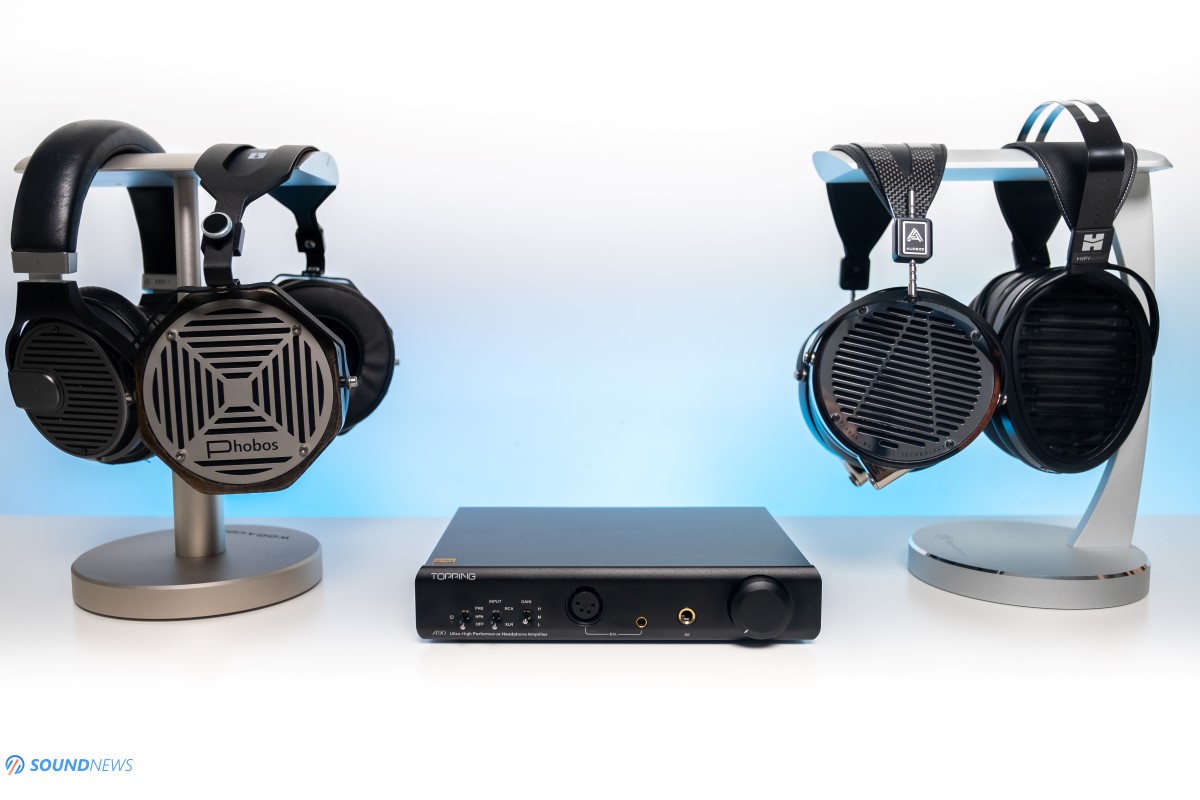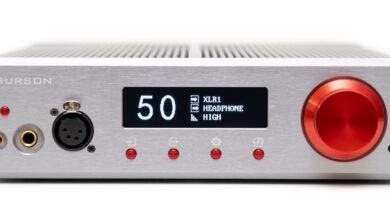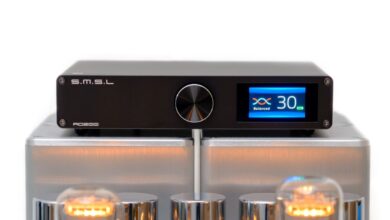Topping A90 Review –The Giant Killer
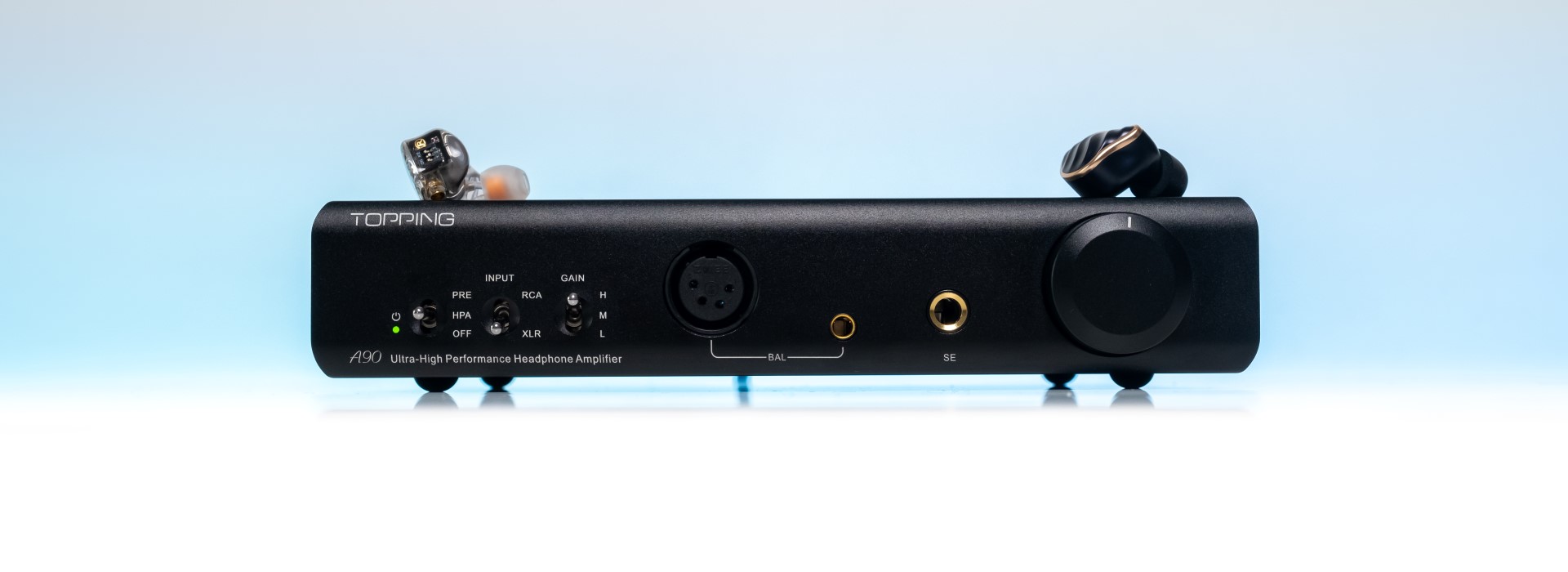
My Video Review:
One of the biggest hypes I ever encountered in the headphone kingdom was the announcement of THX Achromatic Audio Amplifiers that revolutionized the way we listen to music. By far, the biggest impact on the market had the THX-AAA-789 by Drop. The company that made it, prepared a big budget for a powerful marketing push, to me that amp was simply a declaration of war for the expensive and bad measuring headphone amplifiers. The marketing campaign was a great success, because for about a year the demand far outnumbered the supply. If you would be one of the unlucky by wanting one, you needed to wait for the next batch and preorder it at the right minute. It felt like purchasing electronics on-line on Black Friday where everyone wanted the same model at the exact same time. That amplifier reached its goals and to this day more than 7400 units were sold and it is still discussed daily over drop.com, where it has more than 7600 comments.
The biggest change that amplifier brought was not in terms of sound performance or measurements it brought to the table. Before it came to be, everyone was more than happy to pay $1k+ for a premium headphone amplifier, that measured and sounded pretty good, with good connectivity offering single ended and balanced connections. I was one of that person and every single headphone amp in my possession did cost way above $1k. The impact was so big that few of the companies that were making expensive headphone amplifiers, suddenly were struggling and couldn’t move the same number of units after AAA-789 hit the ground. They struggled hard and were obliged to re-think their strategy, releasing newer and better headphone amplifiers that were considerably more affordable.
The biggest paradox is that, as much people hated those commercial operational amplifiers (or op-amps for short) in their high-end electronics, they suddenly started to love them, because THX AAA design in its entirety is a 100% op-amp based feed-forward error correction topology which nullifies conventional distortion to unprecedented low levels that were never achieved until that point. From love to hate and vice-versa is a very thin line and we all know that. Before THX-AAA become a thing, before Drop.com (formerly Massdrop.com) has even existed, there was another topology that created a small cult following, but without a powerful marketing push it wasn’t as successful. I’m about the nested feedback composite amplifiers that are present on the market for more than 50 years now! Most of you already listened to one, JDS Labs El Amp and their Atom are such kind of amplifiers, some of the iFi Audio amplifiers are also composite amplifiers and many others are also using this topology.
The headphone amplifier that I will be testing today is also a Nested Feedback Composite Amplifier, I’m about the Topping A90 that will soon prove its value and demonstrate that there are still things to explore and learn when it comes to amplifiers and topologies. There are a lot of things to love about A90 and very few to nitpick. Don’t you worry, every pros and cons will be mentioned in this review, so let’s carry on and unbox this little big amplifier.

Inside the Box
Since A90 has the exact same dimensions of the case as their D90/D90 MQA units, Topping used the same thick card-board box with lots of foam inside it for protection. Inside you’ll find a power cable, a 6.35mm to 3.5mm headphone adapter so you can use portable headphones with it as well, there is a warranty card and a super-detailed user manual. I’m not very surprised already to see all the possible measurements for their A90, you will find the Signal to Noise Ratio at 50mV and full scale, Dynamic Range, Total Harmonic Distortion + Noise ratio with 32 and 300-Ohm loads, the overall THD versus frequency response and FFT Spectrum.
I was quite moved by the measurements actually, seeing that output power, that super low output impedance and that inaudible noise floor, I’m already expecting great things coming out of this unit.
Topping describes it on their home page as an Ultra High-Performance Headphone Amplifier, but it is also a very good preamplifier that can be used in a speaker setup. The only thing that is missing from the package is a remote control and that is a missed opportunity in my opinion as following my tests in a speaker setup, it shines not only as a headphone amp, but also as a preamp.
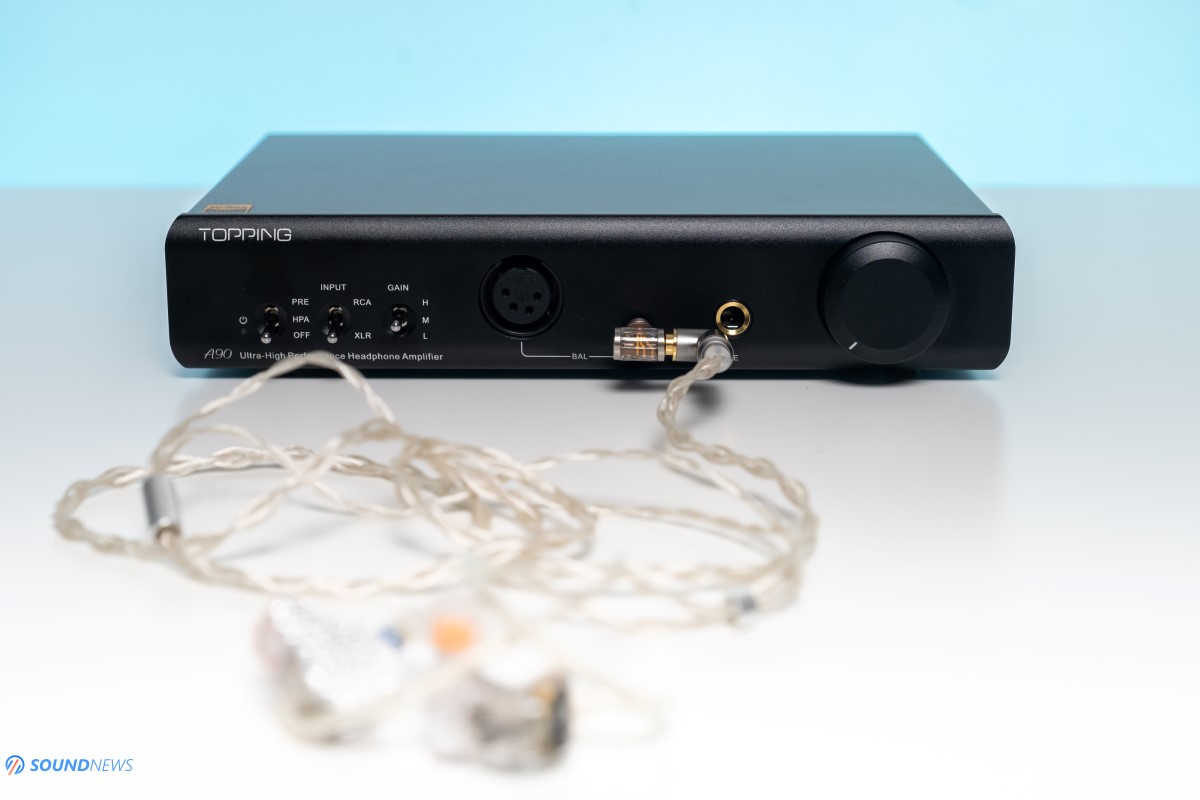
Design & Build Quality
I really liked the look of their DX7 PRO, D90 and D90 MQA and A90 is really no different to those units. It has the same build quality and the same small and simple form factor. It has a small footprint so you’ll have zero issues inserting it in a speaker or headphone setup. The case and the front panel have rounded edges and corners and are quite pleasant to the touch. I personally like the sanded aluminum a little bit more to the anodized one and it suits the A90 really nice with that matte black color or dark silver.
The switches on the front panel have a very firm click and are not wobbling at all, the LED light on the left is dimmed and doesn’t annoy in the dark. The volume knob has a decent amount of resistance so you will not accidentally turn it all the way up as it can happen on the SMSL SP200. The rubber feet are placed in small cut-outs on the metal case itself, so you can be sure that they will not move an inch on the case. There are lots of small details that I’m really liking on this case, for example there isn’t any visible screw on all its sides, giving an impression of a classy handsome look. Probably one the best things to know is that it uses a unibody case with a simple front and back-plate attached to it, so it simply feels really nicely put together. I wish all major companies from the East would put a bigger accent on their designs and looks as Topping does.
You can have it in matte black or dark silver, I received it in black and I like it a bit more in this color option. At about 1.25 Kg or 2.75 pounds it is neither too light or heavy and accidentally leaving your listening area with your headphones attached to it should move it from the table, but not drop it on the ground. Holding it in hand still gives and impression of a well-engineered and well-made product.

Controls & Connectivity
There are several things that I like about A90, it was wise going for the usual stuff as 6.35mm jack and 4-pin XLR jack, but the newest 4.4mm balanced output caught my attention the most – this is currently my favorite connection, its nor too big and nor too small and it could be used for portable and desktop headphones. The surface area is pretty big, so the impedance of a such a connector is a bit lower than that of 2.5 and 3.5mm, meaning a minimal loss of the damping factor. I wish more headphone amp manufacturers would embrace this standard.
Topping put sturdy metal switches on the front, first one will make you choose its working mode: HP amp or preamp, the second is your analog selector – RCA or XLR and the third one is the gain selector having 3 positions: Low, Mid and High. The front panel is straightforward and very simple to use.
On the back you can spot two pairs of analog inputs and outputs coming in RCA and XLR flavors. The line-outputs will make it work as a dedicated preamp in a speaker-based setup, the preamp inside A90 is outperforming the one of D90 and D90 MQA, but without a remote control and motorized volume wheel, I see myself using it only in a near-field setup.

Under the hood of A90
Generally speaking, there isn’t a good and a bad topology when it comes to analog amplification. Amplifier design is a study of compromise, regardless of the technology that is being used. They all have their pros and their cons.
The circuitry inside A90 amp is a combination of multiple op-amps that are cascaded together with a feedback loop. Those feedback loops are negative; thus, it is called a nested-feedback amplifier.
So, what is so cool about a composite topology? Well, first of all it exhibits a higher gain, higher slew rates and much lower distortion. A composite op-amp is placed at the input and the output of another op-amp, in this case it was the (in)famous TPA6120A2 that Topping used. The composite op-amp is basically enhancing the performance level of TPA6120A2 with the help of negative feedback.
The good part is that a circuit like this brings the best of both worlds with excellent DC and AC characteristics, the feedback loop will also remove noise within the circuit.
The bad part of such designs is that feedback loop reduces the overall gain of the circuit, weakening the signal at the output. Sometimes the output resistance could be increased as well. I don’t particularly know how Topping dealt with the output resistance, according to specs it is actually pretty low and I don’t know how they dealt with the overall gain and power output, because clearly A90 is not lacking at all in terms of power output and gain.
If this sounds like some gibberish non-sense, in simple words – these are really high-end features that can be found in very expensive designs. I don’t want throwing stones at nobody so I’ll stop here but I will just mention that A90 is already proved its value to me.
I don’t want to spoil my sources, but Topping is working on this amp exactly from the start of 2019, so they had plenty of time to perfect their circuit and those amplifier modules. They went an extra mile and actually challenged the best headphones amplifiers like Benchmark HPA4 and Drop THX-AAA-789 not only when it came to sound, but also in terms of measurements.
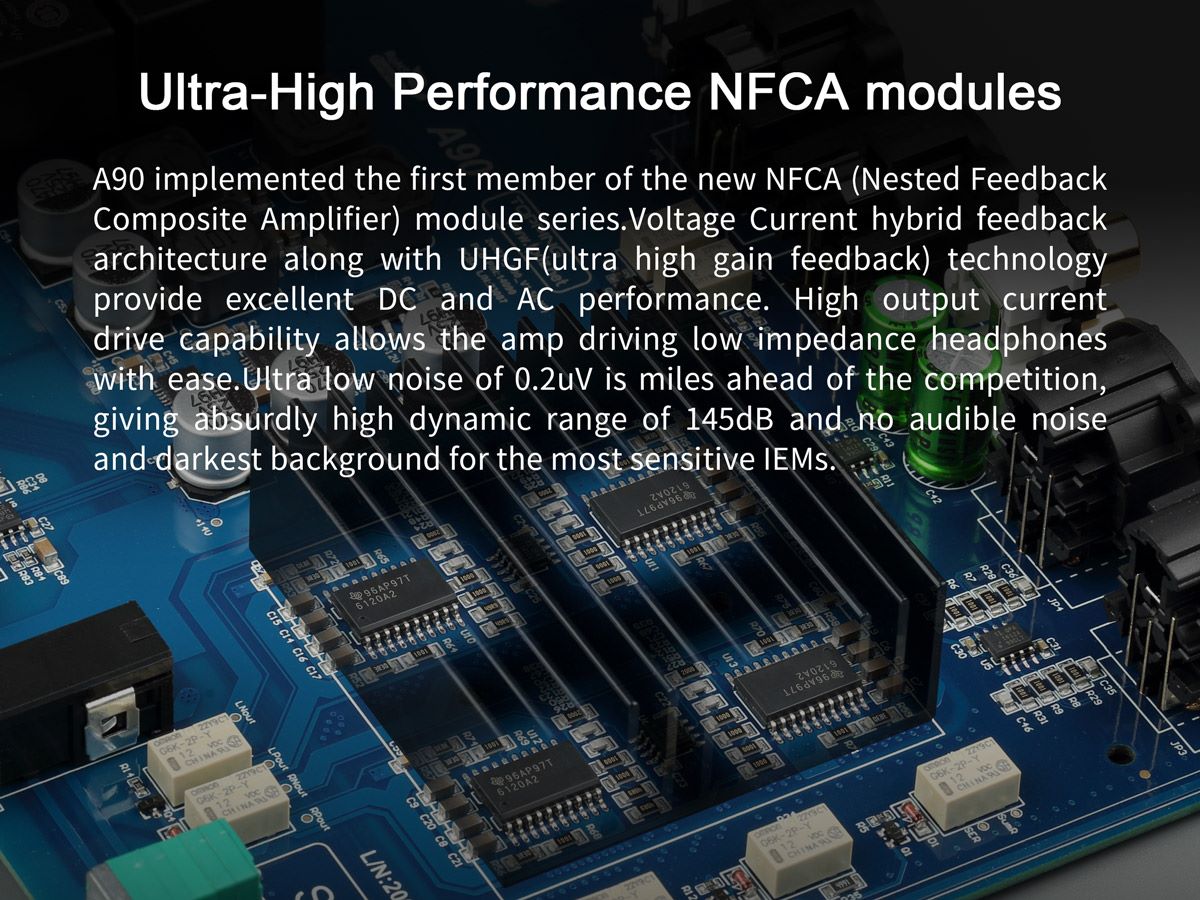
According to AudioScienceReview.com some of the measurements (but not all of them) of A90 outperformed the ones of the $3000 Benchmark HPA4, all of the Drop THX-789 and of SMSL SP200 – all are THX Achromatic Audio based headphones amplifiers. Luckily, I have at my disposal the HPA4 and SP200, so a very interesting comparison will follow very soon.
I will briefly mention that A90 as a headphone amplifier can output some very impressive 7600mW of power in a 16 Ohm load on both the 4-pin XLR and 4.4mm outputs and about 3300mW in 16 Ohms on the 6.35mm jack.
As a preamplifier it can output up to 18 V on the low gain and up to 49 V on the mid and high gain settings.
With specs and measurements like these, Topping is shooting not for the best mid-range amplifier on the market, but for the best headphone amplifier period. That is very dangerous ground, still being bold and cocky is the only way to succeed and I’m liking them for that.

Test Equipment
To hear the A90 at its maximum potential, some high-end sources will be needed. This is why I tested it with 3 different sources to have a better feel about its sound. My test equipment resumed at Matrix Audio Element X, Denafrips Venus and Topping D90 MQA as TOTL DACs. As for headphones, I’ve tested it with super sensitive IEMs, with portable dynamics and with four planar magnetic headphones from which Audeze LCD-4, Hifiman Arya and Erzetich Phobos will squeeze the best it can provide.
Enough with the talk, let’s do some music listening.

Sound Performance
I. Preliminary Impressions & Tonality
Even before listening to A90, researching a lot about its topology, seeing how their engineers counterbalanced the cons of composite amplifiers, seeing those impressive specs and measurements I prepared my body and soul for a long listening session.
The biggest compliment I can give to A90 is that I felt like I opened my windows towards music, I simply experienced the cleanest, the most transparent, colorless and effortless experience I’ve had with headphones. A90 is doing that on such a high level that you will be limited by your source and not by the amp as it usually happens. While listening to A90, you are simply squeezing the best your DAC and headphones could possible deliver, I had the same experience when I first listened to Benchmark HPA4, I simply felt more nuance in my music, more hidden notes, more mastering errors, more of everything and A90 is no different at all to that experience.
When you experience transparency at its purest form, detail at its maximum and the widest bandwidth and at best damping factor, you simply forget about general notions tied to sound quality as frequency response, transparency or transient response. These things don’t matter anymore because they are simply rendered at the best your source and headphones could deliver. A90 feels like listening to the real thing without anything staying in between you and the music. I’m very happy to announce that A90 is really playing at the same level with Benchmark HPA4 and when it comes to solid state electronics, there aren’t better amps that this, at any price point.

II. Resolution & Transparency
This is where A90 feels like the most powerful and beautiful muscle car from the parking lot, it’s simply a head turner, catching attention of everyone passing by. When it comes to resolution and transparency, A90 together with HPA4 are playing this game at the highest level possible. Forget Drop THX-AAA-789, forget Monoprice THX-887, forget SMSL SP200, Topping A90 is still playing that at a higher level than any of those and the only real contender is only the Benchmark HPA4. I’m sad and super pleased at the same time, sad because I still paid $3000 for my Benchmark HPA4, but super pumped and very happy for all the folks that can experience true high-end headphone listening is at only $500, there isn’t a better time to be a headphone listener. I envy about everyone who would experience A90 performance for the first time with goosebumps and cold sweat all over your body.
I went through all the stages of Kübler-Ross curve of change with A90:
- At first it was denial. My HPA4 is still better sounding, it is 6 times more expensive so it should be better, right?
- I started blaming the power cables that were different, I blamed that HPA4 was cold, without any warm-up and that is why both sounded more or less the same.
- Then I felt uncertainty and confusion, I started doubting myself and I started asking questions and researching more about both amps
- Finally, I simply accepted that A90 is on the same level with HPA4
- I moved on and I am happy for everyone else who can experience the same feelings I’m having with HPA4 at a much lower price point!
A90 is simply the definition of an invisible headphone amplifier, it simply takes a step sideways and lets the music flow directly to your ears, without adding or taking away anything from the purity of the musical signal.
A90 is as achromatic (colorless) and as linear and as extended as headphone amplifiers could go and, in this regard, I am placing it at the highest level together with the Benchmark HPA4 as the true rulers of the headphone kingdom when it comes to solid state amplification.
There is a (very) wrong trend going on some forums that a super detailed and transparent source or amplifier would be instantly attributed words as bright, soulless, lean, boring or dry sounding. In my experience, listening to a lot of headphone amps and experiencing one the best ones and everything in between, I can honestly say that absolute linearity, absolute transparency and detail is NOT about being bright, boring or soulless sounding. A90 is anything like that, music is all about emotions, about vibration, about heart beatings, about changing your mood from sad to happy or vice-versa and A90 did that for me every single time.

III. Noise Floor
The key ingredient of unlocking a see-through transparency and the highest level of detail retrieval is having the lowest noise floor possible at any volume level. Easier said than done, because all headphone amp manufacturers are struggling having it under control and as low as possible. Usually a desktop headphone amp will shine the most with desktop headphones and a portable headphone amp will shine the most with portable headphones, both designs cannot work that well with a big variety of headphones because of the background noise or power limitations they have. Topping focused a lot of their efforts in lowering it as much as possible. The fruits of their labor speak for themselves as A90 has a maximum noise level of 1.3 microVolts – this is really world class performance and puts it in the same boat with Benchmark HPA4 and Sparkos Labs Aries!
Without thinking too much, I connected the most sensitive IEMs at my disposal and those were the FiiO FA9 and FH7 IEMs. I tried them on the 6.35 mm jack first, I tried two software players and also Tidal desktop app. Volume wise the highest I could go on low-gain was about 12 O’clock, about 10 O’clock on the mid-gain and about 9 o’clock on the high-gain. The most amazing part? If I would pause my music and go all the way up to maximum volume, no matter the selected gain, the noise floor would be simply undetectable! I’ve heard absolutely nothing; it has simply a noiseless and the blackest background I’ve experienced. I’m very glad to report that A90 works absolutely amazing with IEMs!
On the low gain there is a lot of volume travel on the wheel up to 12 O’clock position so if you like to listen to music late-night at low volumes, you will have plenty of play on that wheel.
Moving on to the 4.4mm jack, the power increased a lot and what was 12 O’clock on the low gain is now at 10 O’clock, on the high gain I can barely move the wheel and it is already very loud. For IEM listeners I would stick to the 6.35mm jack or simply be more careful on the low-gain on the 4.4mm jack.
In terms of noise floor, I experienced few close to perfect designs, but the best ones were always the HPA4 and Sparkos Aries and I’m happy to add the A90 to that list as well.

IV. Transient Response
When you move away that background noise out of the picture, boost its transparency and lower that total harmonic distortion to sub-atomic levels, it would be just natural hearing the highest speed a musical note could deliver and feel the biggest amount of air a musical note could move. A90 is what I call a sleeper headphone amp – it’s quite small that plays in the lightweight category, but when you press play, an unstoppable force will start pounding your ears with increased dynamics. A90 is a nibble, agile and ultra-fast fighter, it is all about speed and punch and you can easily feel that when fast energetic music starts playing.
Funny fact is that it can even transform some of the lazier sounding headphones like Sennheiser Momentum 2 or Meze 99 Classics, it simple enhances the speed of their membranes and lowers the decay making them sound almost like planar-magnetic headphones. The output power plays a bit role here, those 7.6 Watts are adding a lot in terms of dynamics and diaphragm control.
When I’m listening to electronic music via Flux Lab Acoustics FA-10 powering some Audeze LCD-4 it almost feels like a masochistic experience, as you are simply taking an audiophile beating in plain sight, yet it feels so satisfying hearing those bass notes pulsating and pushing more air than its needed.
A90 still can’t pound as hard as Flux Lab Acoustics FA-10 is doing, but it follows its footsteps together with HPA4 and Sparkos Aries. FA-10 is simply a different (untamable) type of beast that can’t control its temper. By comparison, A90 has a calmer personality, yet if you are calling for the thunder, thunder you will get!
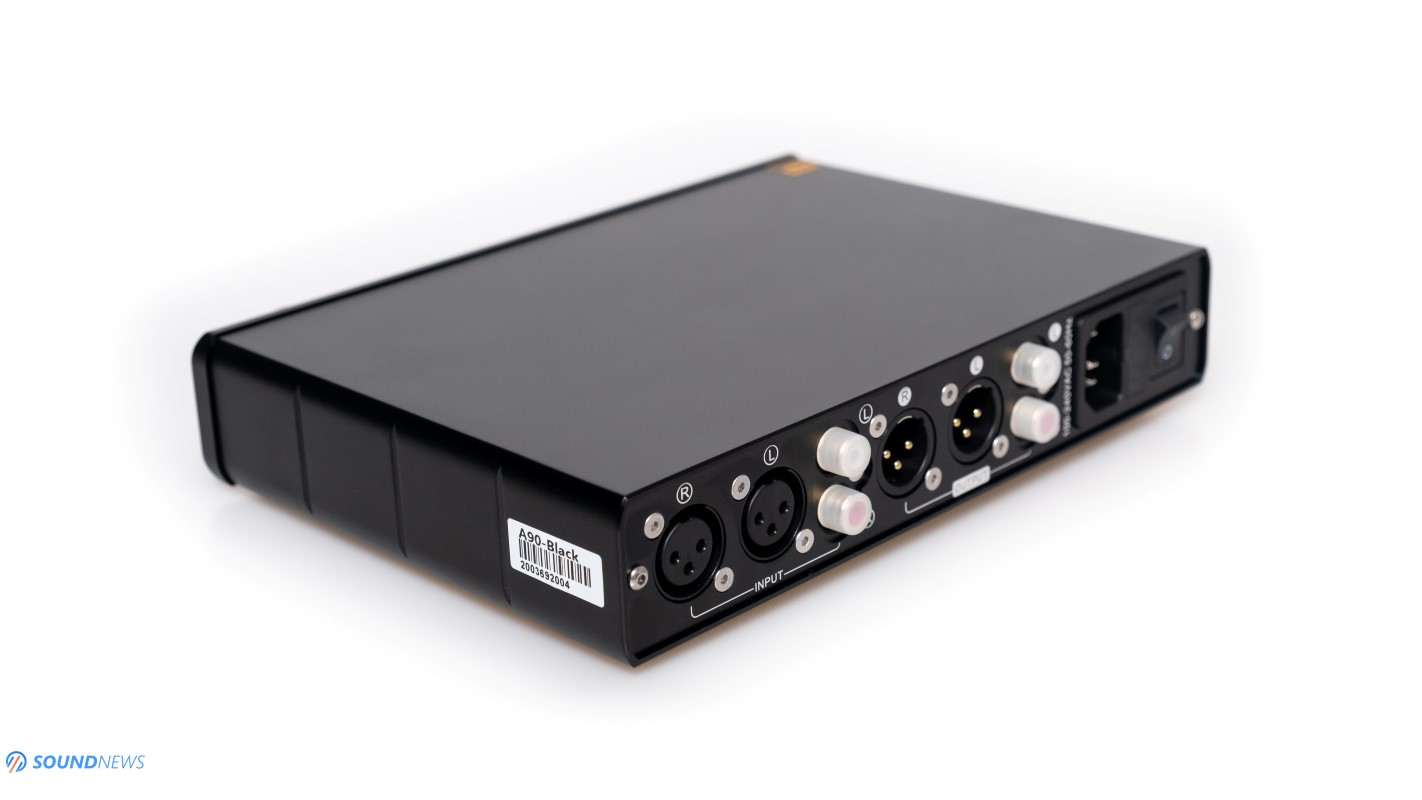
V. Soundstage & Depth
A90 is having a very clean and precise leading edge, a very clean outline of every note, you simply feel its body and its borders, you feel it carrying weight and impact. With a very sharp outline, focusing on all those notes is actually very easy to do. So easy that you no longer need to close your eyes, they are simply flying in the air and you decide to look for them or not. Note placement in the room is excellent and really precise, A90 is without a doubt 3D sounding and holographic if you will. There is no need in giving examples from my music collection, if the record was made in a bigger hall, you will feel that, the borders to which the sounds could fly are not felt. When moving to cozier recordings made in smaller rooms, the stage would decrease in size and you would feel those artists much closer to each other.
I want to point out that A90 will not artificially boost the soundstage size how some amplifiers are doing (mostly tube-based amplifiers) and will render soundstage size as close as possible to the original intent of the mastering engineer. If the record was intended to sound big, wide, tall and deep, then by any means A90 will sound like that and vice-versa, closed-in records will be felt smaller in size to a point of being claustrophobic.
With all that said, I want to point out that while A90 has a great soundstage size on all X, Y and Z axes, this is probably the only area where I feel it is not outperforming the Benchmark HPA4 and Sparkos Labs Aries. The only explanation I can give is the crosstalk between the Left and Right channel that is higher compared to the HPA4, thus a slightly less wide soundstage was felt in the process. HPA4 is also having the widest bandwidth of any amplifier of 0.01 Hz to 500 kHz (yeah, you’ve read that right!) delivering the most precise amplitude and phase accuracy over the entire audio bandwidth so that should also play a role of an airier and wider presentation of HPA4 over the rest.
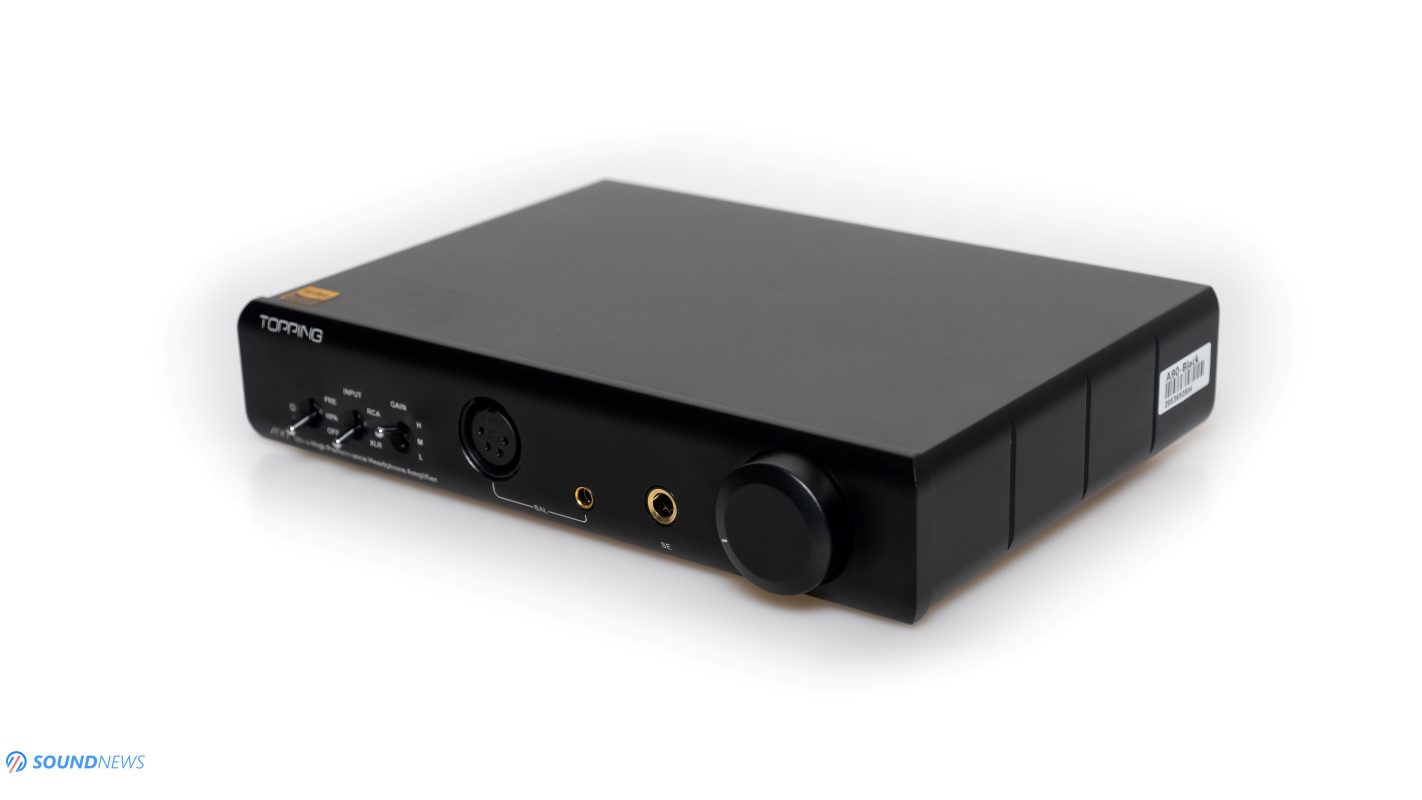
VI. Frequency Response
This will be a very relaxed chapter because A90 is the definition of linearity and by that, I mean simply a perfect frequency response, from the lowest pits of sub-bass information to highest levels of treble, A90 rendered all that without flexing a muscle.
Sub-bass goes to the lowest octaves, it is also incredibly clean, detailed and super tight sounding. If you love accurate, detailed type of bass, then A90 will simply impress from the first second. A friend of mine visited me few days ago, he mixes dark underground psy-trance, he is very much into bass and loves it when it is both clean and deep sounding. After putting the Audeze LCD-4 on its head connected to the A90, I’ve seen how from a blank face, he put on his baby-face smiling all the way, having goose-bumps for few times in a span of about 20 minutes. We discussed about the headphone rig and we both agreed that in terms of bass, it will be hard to outperform this kind of performance.
Midrange had the right tone, voices felt real and had the right pitch, there was naturalness in my old smoky jazz recordings, I felt the raw energy on my older rock tunes. Everything was at its place and from my perspective, midrange simply had the right dose of cleanness and naturalness.
Treble goes high into the sky and can’t be stopped. It is very defined but also really extended in the top octave that improves the performance of the Topping D90 and D90 MQA DACs. A90 is not putting a bigger accent in this region, it is still a very linear amp top to bottom. There is no other way in saying it: A90 is perfect from the perspective of frequency response, it has it the widest and covers our hearing range in its fullest.

VII. Power Output
Audeze LCD-4 and Hifiman Arya are two of the hardest to drive headphones I have tested up to this point, LCD-4 is particularly picky when it comes to power as I have experience them lazy sounding with few particular amps. On the balanced 4-pin XLR and on the high-gain I couldn’t go higher than 12 O’clock position, it was already too loud and mind you, I’m listening to music pretty loud (past 85 dB). Hifiman Arya were very loud at about 11 O’clock. The rest of the gang as Erzetich Phobos and Quad ERA-1 were driven to their fullest at just 10 O’clock volume position.
As you can imagine, A90 has gobs of power and should comfortably drive any headphone from your stable, including the notorious Hifiman Susvara, HE-6 or Abys AB-1266 should be driven at their fullest. A90 is really one of the most powerful headphone amps I had the pleasure of testing, it actually outperforms a bit the Benchmark HPA4 and quite a lot more the Sparkos Labs Aries in terms of pure raw power. As small as it looks, power wise it is actually on the same level with the Burson Conductor 3 Reference and very close to that monstrous 15-kilo Audio-GD Master 9 amp. Flux Lab Acoustics FA-10 still reigns supreme, with its 16 Watts of power you can make your headphones sound as speakers if you want.
Seeing how gracefully A90 moved and controlled the drivers of four planar magnetic headphones, I can assure you that all the dynamic headphones, regardless of manufacturer, price or specs, will be driven to their fullest potential and since A90 is straight as a line when it comes to FR, you will be listening to the sonic character of your headphones and not of the amp itself.
VIII. Comparisons
I will skip all the specs, design, build quality, output power as you can find those by yourself and will focus on the sound quality alone. First of all, you should know that I have compared the Benchmark HPA4 versus Drop THX-AAA-789 and SMSL SP200 (all are THX AAA designs) in a separate article, which you can read right here.

1. Topping A90 ($499 / €499) VS SMSL SP200 ($289 / €299)
A90 reminds the most about the HPA4 and out of all the amps I have tested, it comes the closest to it. SP200 is a good sounding amp too, at 1/10 the price of HPA4 it was quite close but couldn’t challenge the mighty champion. One of the biggest drawbacks of SP200 is its volume wheel. SMSL went with an affordable solution which worked good with desktop and hard to drive headphones, but not that much with IEMs and sensitive portable headphones as it induced a bit of noise and channel imbalance was a real issue at low level music listening. SP200 is having two THX amp modules, compared to four on HPA4 and Drop THX-789, it doesn’t have a true balanced circuit and as a direct result channel crosstalk is higher, resulting in a decent size soundstage, but it is not really holographic and 3D sounding. While it sounds quite good considering its price point, it is still a bit rough around the edges, losing in terms of refinement. You can hardly experience a velvety sound with SP200, it was mostly great with fast music and just good with smooth sounding music.
Topping A90 by comparison, has more power under its belt, has more control of that power and it can sound velvety with some particular songs. A90 sounds considerably more polished and refined. It works absolutely perfect with IEMs, lacking any noise whatsoever and having a much better analogue volume pot. A90 takes all the good parts of SP200, solves all its issue and even adds more inputs and outputs and more setting to play with.
I realized that with acoustic music, A90 will throw a bigger picture in front of me, I would detect easier how far away those notes are flying. Spectral decay was also a bit longer, sounds were decaying naturally, I would simply have more time to hear and feel those notes.
A90 felt a lot more complete in terms of frequency response, it is simply the definition of linearity top to bottom, by comparison SP200 would still lack a tiny bit in terms of sub-bass and treble extension.

2. Topping A90 ($499 / €499) VS Benchmark HPA4 ($3000 / €3500)
For this test, I used the most detailed and extended sounding DAC in terms of Frequency Response and that was the Matrix Audio Element X that was connected to HPA4 and A90 with the same balanced interconnects and both amps were powered by the same power cables. I forgot to mention in the first comparison, that it was mandatory volume-matching both amplifiers before listening and making any judgements, otherwise the loudest sounding amp will simply appear as better sounding, this is how our brain works.
I volume matched them all using the MiniDSP EARS system, my listening volume was set at 85 dB.
As I told you before, I went through all the stages of Kübler-Ross curve of change with A90 versus my own HPA4. In the end, I accepted that A90 is basically the same HPA4 without an LCD screen, without that interesting menu and settings, without a lot more inputs and outputs and without a remote. In terms of sound performance A90 is basically 99% of the HPA4. They are almost undistinguishable and in a blind test I can hardly guess what amp is playing. At only 1/6 of the price, A90 is playing on the same level with HPA4 and this is why I slightly envy all of you who will experience the same feelings I had with HPA4, but a much lower price point.
They both have the same layering, leading edge, detail, outline, frequency response, cleanness, speed and punch. They have the same naturalness and refinement, they are both achromatic and linear sounding, both are following my curve of perfection. A90 simply shares structural DNA with the HPA4 and when it comes to solid state amplification there isn’t anything better than this.

The only area where I’ve felt that HPA4 is outperforming the A90 was the soundstage size and depth, the difference is not that big, but listening to reference recordings with some reference headphones, HPA4 simply outclassed its rival by sounding a bit more open, more 3D and holographic. I am blaming the channel crosstalk which is considerably lower on the HPA4 compared to the A90 and most probably the bandwidth of HPA4 (0.01 Hz to 500kHz) also played a role here, I can only guess at this point. It is clear to me that HPA4 still holds its crown on its iron throne.
Nonetheless, A90 came as the closest to the HPA4 I have encountered up to this point. Forget Drop THX-789, Monoprice THX-887 or SMSL SP200, those are coming close to A90, but are still not playing on the same level. To me, with my own ears and with my equipment, A90 is better than any of those and that tells a lot about the value of the Topping A90!

3. Topping A90 ($499 / €499) VS Flux Lab Acoustics FA-10 ($750)
First of all, I have at my disposal the FCN-10 ($1350) DAC, Streamer and headphone amplifier but I will be using only its headphone amp section, mimicking the FA-10 performance. This comparison was requested by few fellow readers and by some YouTube comments. Saad, this one is for you.
First of all, you should understand the thinking behind both products. Topping wanted to have the most honest sounding amplifier, that is colorless, that doesn’t have a character of its own, that doesn’t add or subtract anything from the music. It will not alter the signal path in any kind of way, it’s the pure definition of a wire with gain.
Flux Lab Acoustics team wanted something different, they wanted to offer that magical Class-A sound, that unique topology and sound signature that less and less manufacturers are working with. Sadly, due to newer legislation and regulations of power consumption all over the globe, Class-A amps will slowly start disappearing from the Hi-Fi landscape. Class-A is having an efficiency of only about ~35%, everything else is transformed into heat that goes to waste. When it comes to sound, FA-10 and most of the class-A amps are all about midrange presence, about hard-slamming bass, about being natural sounding, without a single trace of digitus or brightness. FA-10 is indeed boosting a bit the low-end (bass) and the midrange, it also calms down the treble area by few notches. FA-10 is a warmer and a smoother sounding amplifier, it is all about having a bold sound with a heavy tonality. FA-10 is still the most powerful headphone amplifier with those 16 Watts under its belt. That power translates into an amazing punch and slam into the eardrums, you need to hear to believe that slam with some snappy music. It’s a transient monster when it comes to faster executed notes.
These two designs can’t be compared, it’s an apple vs oranges thing. I personally love both designs, FA-10 works a lot better for simply enjoying your music without thinking about small details, stage size depth, frequency and so on. FA-10 brings more emotions from your tunes and highlights them. It’s a colorful sounding amplifier, it has a slightly warmer tonality and impresses if you looking for an alive and vivid experience.
As I said before, A90 is straight as a line, it is not adding or taking away anything from the music, if it is there, it will play and highlight it. I like both of them, but considering my type of work, A90 is a better tool when I need to review headphones, IEMs, DACs and so on.
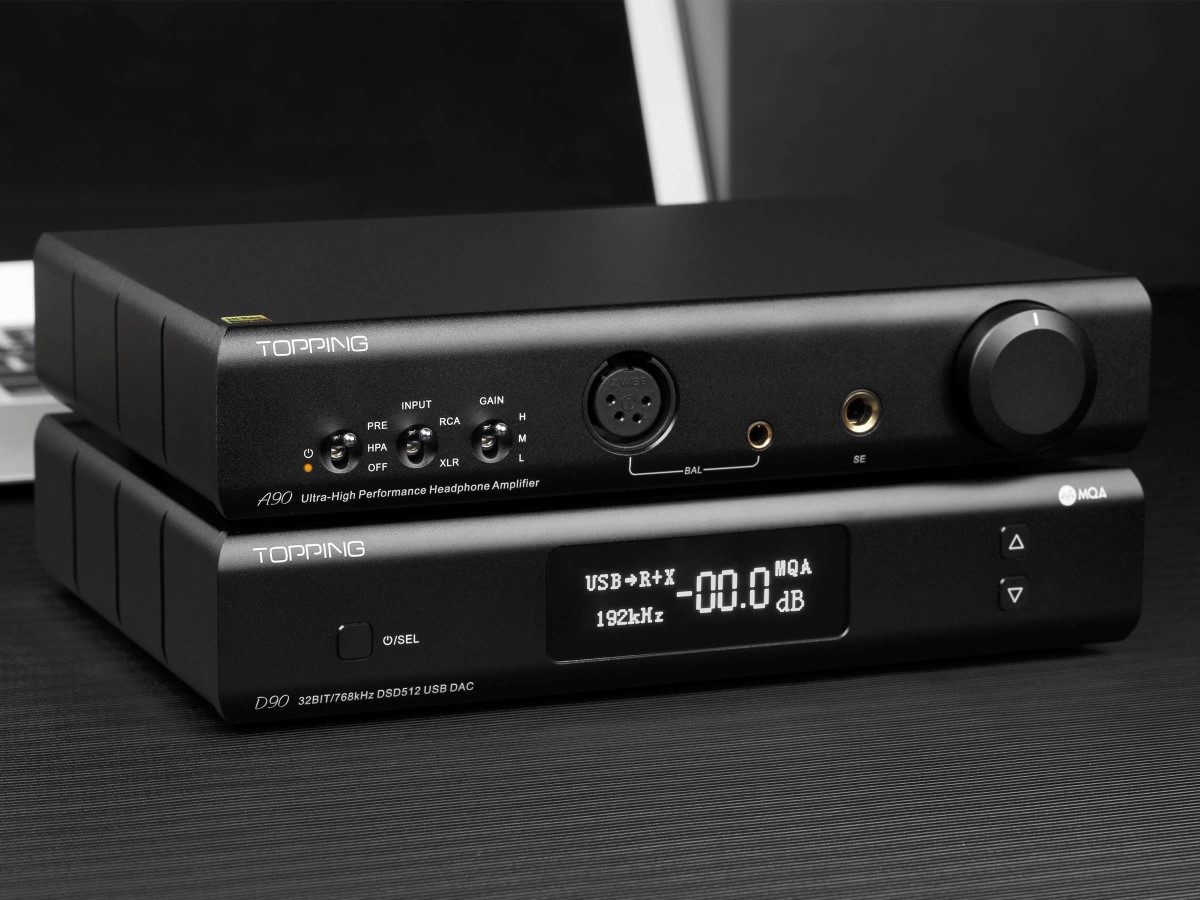
IX. Topping D90 + A90
I will just briefly mention how great this combo sounds. If you followed my Topping D90 and D90 MQA reviews, you would know that Topping went with a heavier tone with both devices, having an amazing bass and midrange performance, but a calmer top-end. D90/D90 MQA are smoother sounding in the treble compared to the most ESS Sabre designs, it boosts the stage size and improves depth information compared to ESS-based ones. I do think that A90 solves the issues of D90 completely, it adds a much-needed speed and slam and it also improves the treble performance quite a bit. D90 or D90 MQA + A90 is a world-class combo that should please headphone and speaker enthusiasts alike, I consider it an end-game setup at mid-fi price.
D90 needed a faster sounding and a wider bandwidth amplifier and A90 is exactly that type of amp, it feels like a Yin Yang thingy, completing each other’s faults. If you own the D90 already, A90 is a must have device for headphone lovers.

Conclusion
It should be pretty clear by now how awesome the Topping A90 is in a headphone setup.
It caters not only to desktop headphone users by offering some juicy 7.6 watts of power, it also caters to the IEMs users but offering one of the lowest noise floor I have ever experienced. Everything I have said about the Benchmark HPA4 in its review can be said about the A90 as well, it is really that good. Considering the price point that Topping went with unit, I’m proud to announce that A90 receives my highest recommendation as being the one of the most complete sounding amplifier at a very attractive price point! It is also the perfect companion for your freshly acquired Topping D90 or D90 MQA DAC.
Topping A90 was provided by Apos Audio, it can be purchased from their web-store by following this link for matte silver or this link for matte black (Apos is offering free shipping in the USA, free 30-day returns in case you don’t like it, an extra 1 year of warranty and lowest price guarantee).
If you get one, please come back and leave a comment, I’m curious to know how it performs in your setup!
PROS:
- Beautiful, simple and sleek looking device
- Solid build quality with an unibody case
- Open wide soundstage, holographic and 3D sounding
- Linear frequency response and super extended on both ends
- The most impressive levels of transparency and resolution
- High-precision pin-point imaging
- Excellent dynamics, pace, rhythm and timing
- Lacks any kind of noise and distortion on any volume level, IEM listeners rejoice!
- Life-like and full-bodied sounding
- A 2-in-1 device that can be used as a headphone amp or as a preamp
- An unbeatable value at this price
CONS:
- Would like to have a remote in the package so I could use it as a preamp far away from the speakers
ASSOCIATED EQUIPMENT:
- DACs: Topping D90 MQA, Matrix Audio Element X, Denafrips Venus, Flux Labs Acoustics FCN-10, Audio-GD R7 (2020 version), SMSL M200
- Headphone Amps: Topping A90, Benchmark HPA4, SparkoS Labs Aries, SMSL SP200, xDuoo TA-30
- Preamps: Benchmark HPA4, Topping A90
- Integrated Amps: Hegel H190, Keces E40
- Power Amp: Keces S125
- IEMs: FiiO FH7, FA9
- Full-sized headphones: Audeze LCD-4, Erzetich Phobos, Hifiman Arya, Quad ERA-1
- Loudspeakers: Buchardt S400, KEF LS50W
- Interconnects: QED Reference XLR (x2), Aune AL3 XLR
- Speaker cables: Kimber PR8, Audioquest Type4
- Power Cables: Isotek EVO3 Premier (x2)
- Balanced Isolation Power Conditioners: PLiXiR Elite BAC400, KECES BP-600
